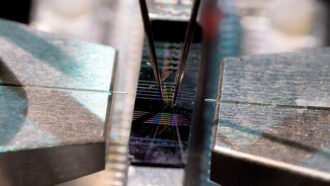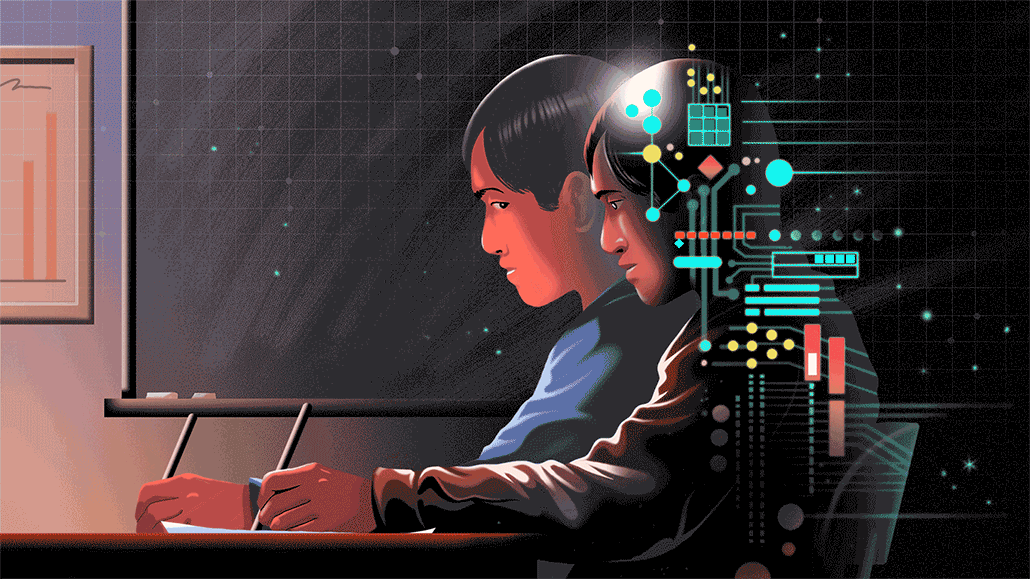These young researchers take aim at sports
Archery apps, safety equipment and a ball-sorting robot all debut at Broadcom science competition
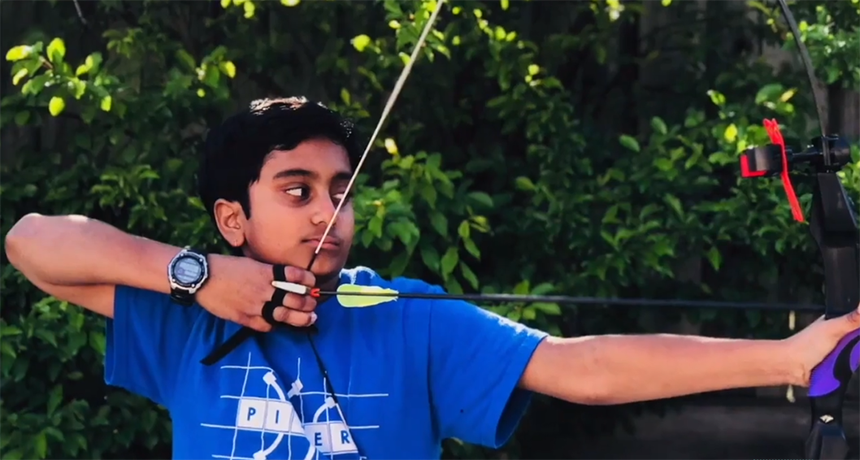
Sriram Bhimaraju invented a device and app to help archers practice their sport. His is just one of the sports-related inventions developed this year by Broadcom MASTERS finalists.
S. Bhimaraju
By Sid Perkins
WASHINGTON, D.C. — Sriram Bhimaraju, 12, has always been interested in archery. That may not be all that surprising for a young man who was named, in part, after Rama, a Hindu god of archery.
With practice, this 7th-grader at The Harker School in San Jose, Calif., has become skilled at his sport. But it’s been hard to develop consistently good technique without coaching, he notes. Hiring a coach for every practice could become quite pricey. And while there are tools that help archers practice alone, some can cost up to $1,000. Sriram’s solution? He used his knowledge of engineering, electronics and computer coding to build a low-cost “archery assistant.”
William Jenkins, 14, plays tennis. So he values the lively bounce in the balls he removes from a newly opened can. But over time, their bounciness wanes. And at first glance, big bouncers look exactly the same as duds. So this 8th grader at The Westminster Schools in Atlanta, Ga., decided to use technology to sort out those aging balls that are losing their bounce. That could be a big time- and cost-saver for tennis centers that sort balls by hand.
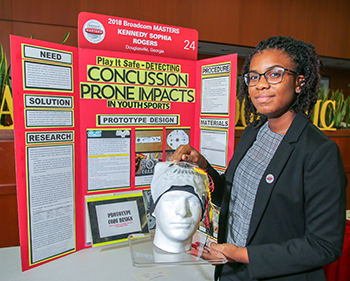
Kennedy Rogers doesn’t play sports. Still, she appreciates the risks that playing some contact sports pose. So this 13-year old at Chapel Hill Middle School in Douglasville, Ga., decided to help coaches identify kids who might have sustained a dangerously hard knock to the head. Concussions are a growing problem for young people, notes Kennedy. The device she developed can alert coaches or others to such possible head injuries.
Like Sriram and William, Kennedy unveiled her invention here, earlier this year, at the Broadcom MASTERS competition. MASTERS stands for Math, Applied Science, Technology and Engineering for Rising Stars. This annual event brings together 30 middle-school students. They work as teams to tackle research challenges. The program was created by Society for Science & the Public, which publishes Science News for Students. Broadcom Foundation, based in Irvine, Calif., sponsors the event.
Unlike most science competitions, only about one-fifth of a finalist’s overall score is based on the qualifying project that he or she had entered at a science fair the year before. The rest of their score comes from their creativity and teamwork. Still, each is proud of the individual research that won them a slot at the national event. Winners can take home big money. And all participants meet peers that may remain friends long after they return home.
Let those arrows fly!
It took Sriram almost a year to develop his archery assistant. Part of that involved physics.
The distance an arrow flies can depend on many things. One is the amount of energy stored in the bow as the archer pulls back on the string. Another is the angle at which the bow is held relative to a vertical line. That angle, in turn, affects the angle at which the arrow points above the horizontal. Other factors such as the speed and direction of the wind can, to a smaller degree, affect an arrow’s flight.
Sriram attached a sensor to the bow. It measures how much potential energy the bow stores when someone pulls back on its string. That sensor is made of a piezoresistive (PEE-eh-zoh-ree-ZIS-tiv) material. It’s a long word. It means that the electrical resistance of the material — how much it impedes, or resists, the flow of electricity through it — changes when the material gets squeezed or bent. So, if a piece of such material is glued to an archer’s bow, its electrical resistance will change as the archer pulls back on the bowstring. In Sriram’s system, data on how much that resistance changed is transmitted wirelessly to a smartphone that’s attached to the bow.
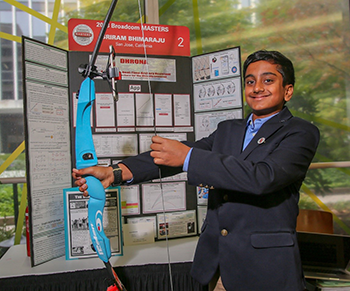
The phone does a couple of other things too, Sriram explains. First, a sensor inside the phone measures the angle at which the bow is tilted. That, plus an estimate of how much energy is stored in the drawn bow, determine how far an arrow should fly when released.
The phone’s computer runs an app that Sriram developed. To use the training aid, an archer starts the app, then enters the distance to a target. (In some competitions, archers shoot at a target 30 meters [98 feet] away, says Sriram. In others, the targets might be 50 meters or even 70 meters away.) Then, the phone starts collecting data from its own sensors, as well as from the sensor mounted on the bow. As the archer pulls back on the bowstring and changes the angle at which the bow is held, the app provides audible feedback advising the archer how to adjust his or her aim. Because the app talks an archer through a shot, even archers who are visually impaired can take part in this sport.
“This project taught me that things hardly ever work on the first try!” Sriram says. For instance, at first he tried taping the piezoresistive sensor to his bow. But he quickly found out that that didn’t work well. He needed to glue it on.
Sriram plans to tweak the app so that it also can account for wind speed and direction. Those data could come from a sensor that plugs right into the phone. That way, he notes, archers can better learn how to compete even when the weather isn’t calm.
For his project, Sriram earned a “Rising Star” award in this year’s competition. He’ll be attending the Intel International Science and Engineering Fair (ISEF) in Phoenix, Ariz., next year, too, as part of the Broadcom MASTERS International event.
Head shot
Concussions are a type of severe head injury. Their symptoms include headache, dizziness and blurry vision. Five times as many people who are 21 or younger were diagnosed with concussions in 2014 as just four years earlier. These head injuries are a special risk in certain contact sports, Kennedy notes. Hard knocks, especially to the head, can be common in athletes who play football or soccer.
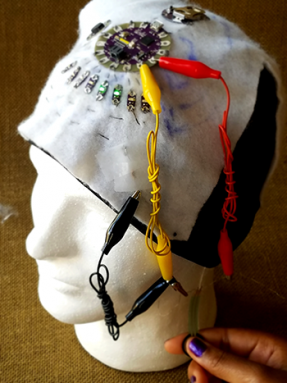
Nobody really knows precisely how strong an impact must be to trigger a concussion. It can be different for different people. It also can depend on how and where someone was hit. Still, a warning that a big knock to the head has occurred might be useful for coaches and team doctors, especially during a game, Kennedy says. “It would allow an athlete to get immediate care and possibly reduce long-term damage,” she says.
Her invention is a cap made of a stretchable fabric to be worn underneath a helmet. A sensor sewn to the cap can detect a sudden impact. It resembles sensors inside phones and laptops. (In those other devices, this sort of sensor shuts down the electronics when it detects an impact. This helps prevent damage to moving parts like disk drives.)
Kennedy sewed a small, flexible circuit board to the cap. It provides the cap’s computing power. Lights and a buzzer provide warnings that a strong impact has been detected. Kennedy’s program allows users to adjust how strong an impact must be before it sets off the alarm.
Like Sriram, early prototypes of her invention didn’t work. For instance, she first tried to sew her sensors and circuits to a headband. But the headband slipped off too easily. As a result, its measurements weren’t reliable. That’s the nature of research. Trial and error. Eventually a working system tends to emerge.
Sorting good from bad
While using relatively “dead” tennis balls can be okay in matches with friends, tennis tournaments require balls to have a certain bounciness. Coaches usually want their players to also practice with these lively balls.
Some training centers have their coaches separate bouncy balls from duds by hand, William notes. That takes a lot of time and can make the process expensive. To avoid that cost, other training centers just replace all their balls on a regular basis. Even though that saves time, it can be wasteful, the teen explains, because it can throw out balls that are still perfectly fine. In either case, U.S. tennis centers throw away tens of millions of balls each year — “enough to stretch from Washington, D.C. to Anchorage, Alaska,” the teen notes.
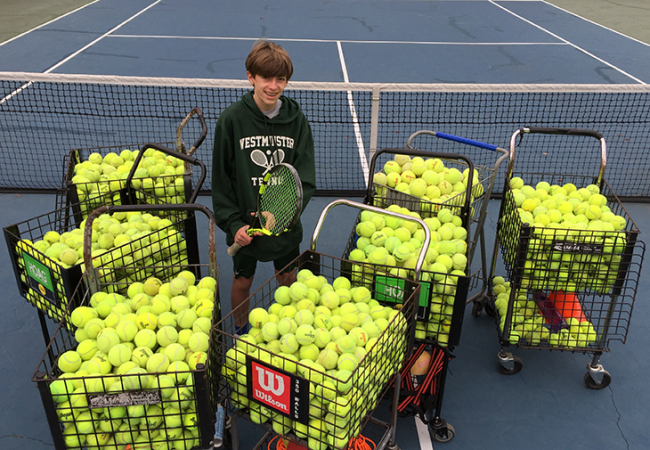
When dropped from a height of 254 centimeters (100 inches), a lively tennis ball will bounce back to a height of between 147 and 153 centimeters. That’s a standard set almost a century ago by the International Tennis Federation, based in London, England. And although that bounce height is measurable — and therefore scientific — it rarely is used. “Usually, people just bounce the ball a few times,” William points out. “With experience, they get ‘a feel’ for the difference between live balls and dead ones.”
William decided to build a simple robot to make that judgment. It has a platform that sits — you guessed it — 254 cm above a slightly tilted surface. His device feeds balls one by one onto that platform. Then, the robot releases a trapdoor, which drops the ball. After the ball strikes the surface, it bounces through a space that’s crisscrossed with light beams. Based on the number and height of the beams that are interrupted as the ball passes through that space, a simple computer program determines whether the ball is lively. If it ball bounces to a proper height, it’s deemed a “keeper” and collected in a bin. Duds go into a separate bin and are trashed.
William’s robot can now sort one tennis ball every 5 seconds. With a little improvement, he thinks he can improve the timing to one every 3 seconds. Once he’s reached that threshold, he’d like to build several robots and then offer their services to the tennis-training centers in his area. William thinks the robots could be the foundation of a good business. That’s because a tennis center typically spends about $10,000 each year to sort tennis balls, and his robots shouldn’t cost nearly that much to build and maintain.
Indeed, with sports of all sorts being such big business, there are plenty of opportunities for inventors like Sriram, Kennedy and William to get in on the action. Good luck, guys!



